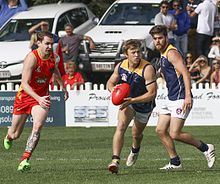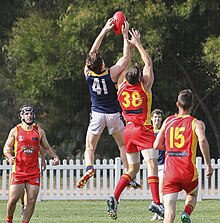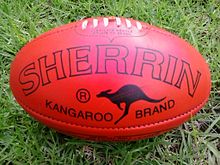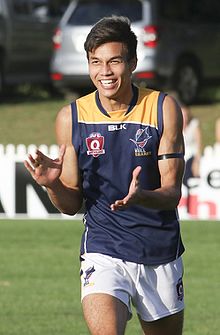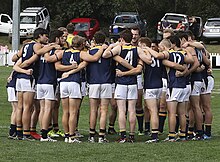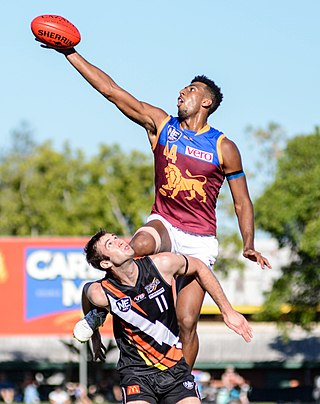
Australian rules football, also called Australian football or Aussie rules, or more simply football or footy, is a contact sport played between two teams of 18 players on an oval field, often a modified cricket ground. Points are scored by kicking the oval ball between the central goal posts, or between a central and outer post.

International rules football is a team sport consisting of a hybrid of football codes, which was developed to facilitate international representative matches between Australian rules football players and Gaelic football players.

A mark in Australian rules football is the catch of a kicked ball which earns the catching player a free kick. The catch must be cleanly taken, or deemed by the umpire to have involved control of the ball for sufficient time. A tipped ball, or one that has touched the ground cannot be marked. Since 2002, in most Australian competitions, the minimum distance for a mark is 15 metres.

Recreational Football was a non-contact version of the Australian rules football game first played in 2003 and later sanctioned by the Australian Football League's game development arm, it was inspired heavily by the growing popularity of tag rugby. It was a more accessible version of Australian rules football that people could pick up and play. It was a mixed competition, with eight players on each team, accessible to players of both sexes, all shapes and sizes and requires minimal equipment to play. Rec Footy was criticised mainly by Australian rules players for appearing similar to netball and being too restrictive, lacking of ability for skilled footballers to run kick and play naturally whilst also penalising newer unskilled players with frequent turnovers.

The laws of Australian rules football were first defined by the Melbourne Football Club in 1859 and have been amended over the years as Australian rules football evolved into its modern form. The Australian Football Council (AFC), was formed in 1905 and became responsible for the laws, although individual leagues retained a wide discretion to vary them. Following the restructure of the Victorian Football League's competition as a national competition and the League's renaming to be the Australian Football League (AFL), since 1994, the rules for the game have been maintained by the AFL through its Commission and its Competition Committee.
In the sport of Australian rules football, the 50-metre penalty is applied by umpires to a number of different infractions when a free kick or mark has already been paid.

A free kick in Australian rules football is a penalty awarded by a field umpire to a player who has been infringed by an opponent or is the nearest player to a player from the opposite team who has broken a rule.

A comparison of American football and rugby union is possible because of the games' shared origins, despite their dissimilarities.
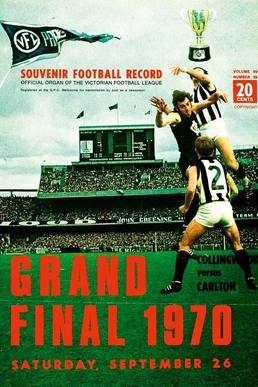
The 1970 VFL Grand Final was an Australian rules football game contested between the Carlton Football Club and Collingwood Football Club, held at the Melbourne Cricket Ground (MCG) on 26 September 1970. It was the 73rd annual Grand Final of the Victorian Football League, staged to determine the premiers for the 1970 VFL season. The match was won by Carlton by a margin of 10 points, marking that club's 10th premiership victory.
This is a general glossary of the terminology used in the sport of rugby union. Where words in a sentence are also defined elsewhere in this article, they appear in italics.
Rugby league football has accrued considerable jargon to describe aspects of the game. Many terms originate in the Laws of the Game. Some aspects of the game have more than one term referring to them. Different terms have become popularly used to describe an aspect of the game in different places, with notable differences between the Northern and Southern Hemispheres.
The 1977 VFL grand final was a series of two Australian rules football matches between the North Melbourne Football Club and the Collingwood Football Club. Together they are considered the 80th and 81st grand finals of the Victorian Football League and were staged to determine the premiers for the 1977 VFL season. The premiership is usually decided by a single match; however, as the first grand final ended in a draw, a grand final replay was played the following week and was won by North Melbourne. Both grand finals were held at the Melbourne Cricket Ground. The first was held on 24 September 1977. The game was attended by 108,224 spectators and ended in a draw, with both teams scoring 76 points. This was the second time a draw had occurred in a VFL grand final, the first being in 1948.
Variations of Australian rules football are games or activities based on or similar to the game of Australian rules football, in which the player uses common Australian rules football skills. They range in player numbers from 2 up to the minimum 38 required for a full Australian rules football.

The 2009 AFL Grand Final was an Australian rules football game contested between the St Kilda Football Club and the Geelong Football Club at the Melbourne Cricket Ground on 26 September 2009. It was the 113th annual grand final of the Australian Football League, staged to determine the premiers for the 2009 AFL season.
There are various individual skills and team tactics that are required to play Australian rules football effectively. These are dictated by tradition and the sport's laws.
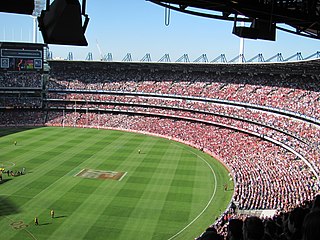
The 2012 AFL Grand Final was an Australian rules football game contested between the Hawthorn Football Club and the Sydney Swans at the Melbourne Cricket Ground on 29 September 2012. It was the 117th annual grand final of the Australian Football League, staged to determine the premiers for the 2012 AFL season. The match, attended by 99,683 spectators, was won by Sydney by 10 points, marking the club's fifth VFL/AFL premiership victory. Sydney's Ryan O'Keefe was awarded the Norm Smith Medal as the best player on the ground.

The 2017 AFL Grand Final was an Australian rules football game contested between the Adelaide Football Club and the Richmond Football Club at the Melbourne Cricket Ground on 30 September 2017. It was the 122nd annual grand final of the Australian Football League staged to determine the premiers for the 2017 AFL season. The match, attended by 100,021 spectators, was won by Richmond by a margin of 48 points, marking the club's eleventh VFL/AFL premiership and first since 1980. Richmond's Dustin Martin was awarded the Norm Smith Medal as the best player on the ground.

The 2022 AFL Grand Final was an Australian rules football match contested between Geelong and the Sydney Swans at the Melbourne Cricket Ground on 24 September 2022. It was the 127th grand final of the Australian Football League (AFL), staged to determine the premiers of the 2022 AFL season. The match, attended by 100,024 spectators, was won by Geelong by a margin of 81 points, marking the club's tenth VFL/AFL premiership. Isaac Smith of Geelong won the Norm Smith Medal as the player judged best on ground.
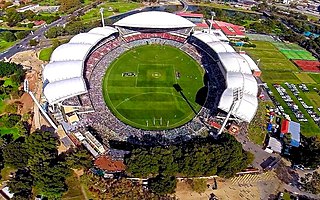
The 2022 AFL Women's season 6 Grand Final was an Australian rules football match held at the Adelaide Oval on 9 April to determine the premiers of the sixth season of the AFL Women's (AFLW) competition.

The 2022 AFL Women's season 7 Grand Final was an Australian football match held at the Brighton Homes Arena on 27 November 2022 to determine the premiers of the seventh season of the AFL Women's (AFLW) competition. The match was contested between the Brisbane Lions and the Melbourne Football Club. It was played in 30 °C (86 °F) heat. Melbourne emerged as winners by four points.


